Sarah L. Johnson's Blog, page 138
August 12, 2011
Reviews of obscure books: Silk and Stone, by Dinah Dean
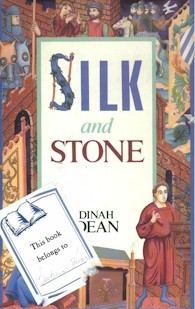 It's been well over a year since my last entry in the Reviews of Obscure Books series, so I figured it was about time for a new one. This is my copy of Dinah Dean's Silk and Stone, and when you find a book as obscure as this one is, you don't care that one of its past owners slapped an ugly bookplate on the front cover rather than on the flyleaf. Well, actually that's not true, but I'll deal with it.
It's been well over a year since my last entry in the Reviews of Obscure Books series, so I figured it was about time for a new one. This is my copy of Dinah Dean's Silk and Stone, and when you find a book as obscure as this one is, you don't care that one of its past owners slapped an ugly bookplate on the front cover rather than on the flyleaf. Well, actually that's not true, but I'll deal with it.Among others, Dean has written six mostly unconnected novels that take place in Waltham Abbey in Essex between the 11th and 19th centuries. Silk and Stone, the 2nd in this unofficial series, is set during the civil wars between King Stephen and Empress Matilda in the 1140s. But while the main characters all end up in the East of England, the novel begins on a pilgrimage far to the east and south.
Norman lady Mabilia de Wix, her 17-year-old daughter Elys, and their maid are in Rome, having traveled there in the company of Mabilia's haughty brother, Templar knight Sir Richard de Hastings. Elys's older brother Matthew has a wound in his foot that refuses to heal, and the women have made pilgrimages to holy places all over England and France in the hopes of curing him. All have failed, and they don't understand why. Novelist Diana Norman would have made a slyly irreverent remark about this over-the-top situation, and indeed I expected one, but here, the novel's gentle humor mingles with sadness. Unless Matthew lives, the family's noble line will die out.
If that's not bad enough, Elys hates the thought of going into a convent. Mabilia has plans to retire to the cloister, seeing it as the safest place during these traumatic times of constant war, and wants to see Elys settled there too. Elys's dowry has already been given to the nuns, so she has no hope for a decent marriage. Elys has other plans, though. An accomplished needlewoman, she thinks she has what it takes to be a professional broiderer.
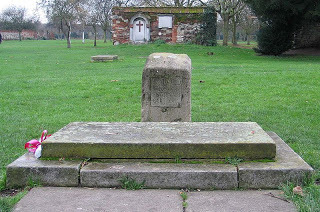
The legendary tomb of King Harold II, which resides in Waltham
and is mentioned in the novel
Aylwin of Winchester, a master mason from a noble Saxon bloodline, sympathizes with Elys's predicament, and they become friends as he, his friend Sir Fulk, and her family wander back to England together. Her quest for independence gains ground in the town of Waltham Abbey; she impresses Father Warmand with her skill, and he hires her to design and sew an elaborate cope, or church vestment.
With her unorthodox choice of career, her refusal to become a nun, her mother's and uncle's disapproval, and Sir Fulk's unwillingness to marry her despite his obvious admiration, Elys has her hands full. Aylwin has feelings for her, but Elys is still blind to his attentions. Matthew's days are numbered, too; only a miracle can cure him. Fortunately, one may be at hand.
This isn't a good book on which to test the 50-page rule. Today's commercial fiction is obliged to grip the reader's attention immediately, but the initial few chapters of this one are slow. Imagine the pacing of a pilgrimage in the Middle Ages, and you'll get an idea of how slow. Things pick up as the plot begins to cohere, happily, and as Elys emerges as the novel's central figure.
Her plight is easy to understand — who would want to be forced into a nunnery? — but she belongs to her time rather than ours. Her romance with Aylwin develops realistically, with the shadow of the Norman Conquest, some seventy years earlier, still lingering in the background. She also doesn't realize how fortunate she is, not until later. Through the depiction of Elys's older sister Judith, who is now called Sister Helen, readers get to see the bitter result of a woman's regret-filled life.

The nave of Waltham Abbey
Dean presents a wonderfully detailed tapestry of the English medieval world, presenting the day-to-day occupations and concerns of nobility, craftspeople, and churchmen, although the weave isn't always as fine as it could be. In some scenes, she spoon-feeds information on England's political history; in others, she drops readers into a pile of medieval terminology and lets them sort out what's what. I liked the latter approach. The word "mystery" is used in the sense of "miracle," and to her credit, Dean explores her characters' religious mindsets without making them seem holier-than-thou. Instead, their faith feels like a natural part of their existence, which it was.
In her author's note, placed at the very beginning, Dean writes that many of her characters once lived, and that much of her plot is historically based rather than fictional. Lady Mabilia, Sir Richard, Matthew, and several of the townspeople are among the real ones, all mentioned in a chronicle written forty years later.
Dinah Dean's Silk and Stone was published by Barrie & Jenkins, London, in hardcover in 1990 (382pp). The RomanceWiki page has a complete bibliography of her work. Should you be interested in a copy of this one, there are a couple of reasonably-priced ones on Amazon UK. For now.
Published on August 12, 2011 20:26
August 9, 2011
Book review: The Last Time I Saw Paris, by Lynn Sheene
 Lynn Sheene takes risks with her heroine, Claire Harris Stone, by making her a gold-digging Manhattan socialite. In May 1940, with the world on the brink of war, she shamelessly flirts with her husband's German clients to soften them up for business deals. Over the course of her debut novel The Last Time I Saw Paris, Sheene successfully transforms Claire into a woman who's much more selfless and sympathetic, but just as courageous and hard-edged - thanks to the considerable risks Claire takes for herself.
Lynn Sheene takes risks with her heroine, Claire Harris Stone, by making her a gold-digging Manhattan socialite. In May 1940, with the world on the brink of war, she shamelessly flirts with her husband's German clients to soften them up for business deals. Over the course of her debut novel The Last Time I Saw Paris, Sheene successfully transforms Claire into a woman who's much more selfless and sympathetic, but just as courageous and hard-edged - thanks to the considerable risks Claire takes for herself. When her husband discovers she's not the blue-blood she claimed to be, Claire flees New York for Paris, the promised City of Light, hoping to connect up with a former lover. Germany has just invaded Poland, but Claire is still taken aback when the Nazis move in to occupy the city. (Her naïveté defies belief at times, especially given her street-smarts in other respects.) She takes refuge with an aristocratic florist, Madame Palain, who employs her under the table. Claire agrees to help the Resistance only because they can provide the fake identity papers she needs.
Madame Palain knows the importance of beauty during hard times and vows to keep her shop open. The floral deliveries Claire makes to Nazi gatherings at swanky hotels gives her the chance to gain intelligence for her contacts, who include an Englishman named Thomas Grey - a friend of her old lover. As she and Grey walk through the Luxembourg Gardens together, exchanging information, their opinions toward one another gradually shift until she comes to care for him and his safety more than she does for herself. Then her cover is blown, for a second time.
The novel offers up a vivid yet stark vision of a cultured European city at one of its darkest hours. Danger is ever-present; people are detained, carted away, and shot for the slimmest of "offenses," and fear and desperation become a tragic part of life. But despite the unease that grips northern France, the indomitable spirit of Paris endures and is described in terms that suit its nature. One park is "a stately woman, her well-bred bones showing through the ravages of the season." The plot grows increasingly suspenseful as the months and years pass under the Occupation, and as Claire is exposed to greater peril.
The ending raises more questions than it answers, but The Last Time I Saw Paris is well worth reading for its page-turning storyline, edgy atmosphere, and progressive insight into the character of a determined woman with a strong instinct for survival.
The Last Time I Saw Paris appeared in May from Berkley at $15/$17.50 in Canada (trade paperback, 354pp).
Published on August 09, 2011 17:00
August 6, 2011
Book review: Before Ever After, by Samantha Sotto
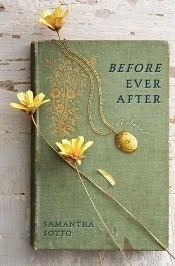 Get ready for the unexpected when you pick up this offbeat, incredibly enjoyable novel, which will transport you on a memorable journey through Europe old and new.
Get ready for the unexpected when you pick up this offbeat, incredibly enjoyable novel, which will transport you on a memorable journey through Europe old and new.American expat Shelley Gallus had put her life on hold after her husband, Max, was killed in a Madrid train bombing three years earlier. When a man who is his spitting image rings her doorbell in London, claiming to be Max's grandson, Paolo, Shelley refuses to believe this time-bending impossibility. That is, until the similarities between Max and Paolo's beloved and seemingly ageless "Nonno" become too profound to ignore.
She and Paolo board a plane for the Philippines, where he believes Max has resurfaced. Shelley's reminiscences about how she and Max first met form the heart of the novel, and although its structure jumps around a lot, the story is easy to follow. Max had been her guide on a laid-back package tour through the back roads of Europe that Shelley joined on impulse.
As the tour group's VW van rumbles along from the steps of Montmartre to Switzerland's Emmental Valley, and from the red-roofed skyline of Slovenia's capital to the shadow of Mt. Vesuvius, Max recounts folkloric vignettes from history, each one set further back in time. Each is a perfect little slice of the past featuring ordinary people, their difficult times, and how they fought to save their loved ones.
Back on the plane with Paolo, Shelley realizes that perhaps Max's stories were more than that. Perhaps they were his way of telling the truth about himself.
Sotto's deceptively slim debut is as rich and satisfying as one of Max's famous baked egg and cheese breakfasts, minus the calories and cholesterol. Its tone moves from zany to thoughtful to painfully sad and back again, all the while evoking the lengths people travel for love.
Before Ever After was published by Crown in August at $23.00/$25.95 in Canada (hardcover, 294pp). Stop on over to the author's website for back story, her blog, a virtual tour of the places in the book, and pics of the cutest little VW van. This review was first published in August's Historical Novels Review.
Published on August 06, 2011 20:15
August 3, 2011
An interview with Sonia Gensler, author of The Revenant
You'll find Sonia Gensler's The Revenant shelved in the Teen Paranormal Romance section at your local bookstore. However, it has far more in common with creepy supernatural mysteries like Patricia Clapp's Jane-Emily and Sarah Waters' The Little Stranger than it does with Twilight and its ilk.
The year is 1896, and 17-year old Willemina Hammond is desperate. To escape a home situation she detests, she boards a train from Tennessee to Indian Territory and steals the identity of one of her former classmates. But Willie's assumed role as an English teacher at the Cherokee Female Seminary in Tahlequah, Oklahoma is nothing like she expects.
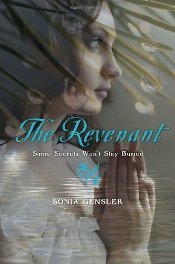 Willie struggles to gain authority over her cliquish pupils, who are the same age as she is, and whose upper-class background gives them a sophistication she herself doesn't have. Then Willie learns that her bedroom used to belong to a former student who drowned in the river last year. What's causing the tapping on her window after dark — is it poor Ella's ghost, and if so, what does Ella want to tell her? What ever happened to the boy rumored to be Ella's lover? And can a romance between Willie and Eli Sevenstar, a handsome older student at the male seminary across town, ever work out?
Willie struggles to gain authority over her cliquish pupils, who are the same age as she is, and whose upper-class background gives them a sophistication she herself doesn't have. Then Willie learns that her bedroom used to belong to a former student who drowned in the river last year. What's causing the tapping on her window after dark — is it poor Ella's ghost, and if so, what does Ella want to tell her? What ever happened to the boy rumored to be Ella's lover? And can a romance between Willie and Eli Sevenstar, a handsome older student at the male seminary across town, ever work out?
The Cherokee Female Seminary was a real place, an institution of higher learning for wealthy Cherokee girls and lower-class scholarship students. Its building — a three-story, turreted structure that resembles a castle — is now part of the Northeastern State University campus. I loved walking through the rooms of the seminary along with Willie, noting the fully stocked library and gleaming wood tables and chairs. Willie's awkward experiences in front of a classroom ring true, the depiction of late 19th-century Cherokee life is seen from an intriguing new perspective, and the ghost story is eerie and unpredictable. The Revenant is an engrossing read which should appeal equally well to adults and YAs.
I hope you'll enjoy the following interview!
I wasn't familiar with the term "revenant" before picking up your book. What's the difference between a revenant and a regular ghost, if there is such a thing?
I don't think there really is a difference. Revenant, with its French origins, seemed a more old-fashioned and romantic word to me than ghost, and over the course of the story I was able to give a double meaning to its definition of "one who returns." I think the term can include creatures such as vampires or zombies, but obviously I didn't go in that direction for this story!
How do you get into the right mood for writing scary scenes, like the ones in which Willie hears mysterious tapping at her window very late at night?
No one has asked this question before! Actually, it's sort of the same as when I write romantic scenes. I rarely try to "set the mood" – I don't have to be scared in order to write a scary scene. At times I try to remember moments when I was scared, but I have to be thinking pretty calmly and objectively in order to write about those moments. When the scene is stubbornly refusing to flow, I might review scary scenes from favorite ghostly novels for inspiration.
Now that I see how mundane my answer is, I'm tempted to light candles and play spooky music next time I have to write a scary scene, just to see how that affects the process!
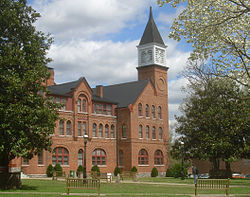 The former Cherokee Female Seminary, now Seminary Hall,
The former Cherokee Female Seminary, now Seminary Hall,
Northeastern State UniversityI found your depiction of the Cherokee students and their families fascinating and enlightening, because it's a chapter of their history - and a segment of the population - you don't often read about. What sort of research did you do to ensure that the Cherokee characters were portrayed correctly?
For my research I visited the Oklahoma Historical Society and the Northeastern State University Archives. I also had the benefit of reading Devon Mihesuah's Cultivating the Rosebuds: The Education of Women at the Cherokee Female Seminary, 1851-1909 as well a collection of oral histories entitled Cherokee Female Seminary Years, edited by Maggie Culver Fry. These books, along with the photographs, school catalogs, architectural plans, etc. obtained through the archives, gave me a pretty clear background on the history of the town, seminaries, and people. Once I had a draft, I arranged for an introduction to Dr. Richard Allen, former English teacher and current policy analyst for the Cherokee Nation. He kindly agreed to read the manuscript for me and offered valuable insights on historical context and characterization.
What sorts of things did you discover while doing on-site exploration of the old seminary building that you wouldn't have known about otherwise?
I think it was during a tour that I learned what parts of the building were off-limits to male seminary students. When invited to the school, boys were allowed access to the first floor, but could only step as far as the first landing on the staircase to the second floor. They were NOT to go to near the girls' bedrooms. This wasn't surprising information by any means, but it did get me thinking about certain plot points . . .
I know it may not be fair to ask a teacher to choose a favorite student, but were there any of the girls (or boys) whose backstory or character you enjoyed developing the most?
Fannie and Larkin Bell weren't necessarily my favorite characters, but I did enjoy fleshing them out as the "mean girl" and her rakish older brother. It was especially fun to imagine their home for the Christmas party scenes – the house was loosely based on Rose Cottage in Park Hill, the home of Chief John Ross. Fannie is a royal pain, but I tried to show her strengths as well as flaws. I like to imagine that her frightening experiences at the seminary tempered her vanity and snobbery.
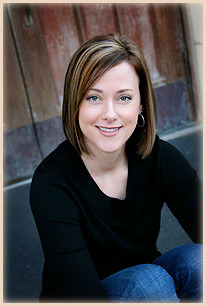 Author Sonia GenslerWillie's enthusiasm for Shakespeare's plays comes through clearly to her students at the Cherokee Female Seminary. Back when you were a teacher, did you have any favorite Shakespeare plays to read and act out with your classes?
Author Sonia GenslerWillie's enthusiasm for Shakespeare's plays comes through clearly to her students at the Cherokee Female Seminary. Back when you were a teacher, did you have any favorite Shakespeare plays to read and act out with your classes?
I required my English II students to act out the assassination scene from Julius Caesar every year. They usually had a great time with that. It was a complicated and often maddening effort to throw costumes and props together and, after much rehearsing, film the scene. The experience certainly made for a great discussion when the students compared their version to the same scene in the 1970 film adaptation of the play, which portrays the assassination very . . . vividly.
Were there any fascinating tidbits you picked up during the writing process that you wanted to use in The Revenant but were unable to?
During the research process I went on one of the Haunted Seminary Hall tours, which are offered every October by Northeastern State University graduate students. At one point the guide took us to the second floor and, after pushing aside a tile from the drop ceiling, showed us what certainly looked like footprints on the original plaster ceiling. It was quite eerie, and no one had an explanation for it. I wish I could have worked that into the story somehow, but the proper way to include it never came to me.
Although Willie's only seventeen, the role she assumes puts her in an unusual position - she's expected to associate with other adults rather than students of her own age. For this and other reasons, I could easily see your book appealing to both YAs and adults. Did you deliberately set out to write a novel for the YA market, or didn't you have an age group in mind?
I did set out to write The Revenant as a YA book, but with the knowledge that YA has considerable crossover appeal to the adult market these days. The teen years are inherently full of drama and conflict, and I feel that most adults still have vivid memories of that time in their lives. I also liked the idea of my protagonist putting on a performance, and in this case, she was pretending to be an adult – a common fantasy for teens.
Thank you, Sonia!
------
The Revenant was published in June by Knopf in hardback ($16.99/$18.99 Canadian, 322pp). Visit Sonia's website at www.soniagensler.com for biographical information plus more historical background on the novel.
The year is 1896, and 17-year old Willemina Hammond is desperate. To escape a home situation she detests, she boards a train from Tennessee to Indian Territory and steals the identity of one of her former classmates. But Willie's assumed role as an English teacher at the Cherokee Female Seminary in Tahlequah, Oklahoma is nothing like she expects.
 Willie struggles to gain authority over her cliquish pupils, who are the same age as she is, and whose upper-class background gives them a sophistication she herself doesn't have. Then Willie learns that her bedroom used to belong to a former student who drowned in the river last year. What's causing the tapping on her window after dark — is it poor Ella's ghost, and if so, what does Ella want to tell her? What ever happened to the boy rumored to be Ella's lover? And can a romance between Willie and Eli Sevenstar, a handsome older student at the male seminary across town, ever work out?
Willie struggles to gain authority over her cliquish pupils, who are the same age as she is, and whose upper-class background gives them a sophistication she herself doesn't have. Then Willie learns that her bedroom used to belong to a former student who drowned in the river last year. What's causing the tapping on her window after dark — is it poor Ella's ghost, and if so, what does Ella want to tell her? What ever happened to the boy rumored to be Ella's lover? And can a romance between Willie and Eli Sevenstar, a handsome older student at the male seminary across town, ever work out?The Cherokee Female Seminary was a real place, an institution of higher learning for wealthy Cherokee girls and lower-class scholarship students. Its building — a three-story, turreted structure that resembles a castle — is now part of the Northeastern State University campus. I loved walking through the rooms of the seminary along with Willie, noting the fully stocked library and gleaming wood tables and chairs. Willie's awkward experiences in front of a classroom ring true, the depiction of late 19th-century Cherokee life is seen from an intriguing new perspective, and the ghost story is eerie and unpredictable. The Revenant is an engrossing read which should appeal equally well to adults and YAs.
I hope you'll enjoy the following interview!
I wasn't familiar with the term "revenant" before picking up your book. What's the difference between a revenant and a regular ghost, if there is such a thing?
I don't think there really is a difference. Revenant, with its French origins, seemed a more old-fashioned and romantic word to me than ghost, and over the course of the story I was able to give a double meaning to its definition of "one who returns." I think the term can include creatures such as vampires or zombies, but obviously I didn't go in that direction for this story!
How do you get into the right mood for writing scary scenes, like the ones in which Willie hears mysterious tapping at her window very late at night?
No one has asked this question before! Actually, it's sort of the same as when I write romantic scenes. I rarely try to "set the mood" – I don't have to be scared in order to write a scary scene. At times I try to remember moments when I was scared, but I have to be thinking pretty calmly and objectively in order to write about those moments. When the scene is stubbornly refusing to flow, I might review scary scenes from favorite ghostly novels for inspiration.
Now that I see how mundane my answer is, I'm tempted to light candles and play spooky music next time I have to write a scary scene, just to see how that affects the process!
 The former Cherokee Female Seminary, now Seminary Hall,
The former Cherokee Female Seminary, now Seminary Hall, Northeastern State UniversityI found your depiction of the Cherokee students and their families fascinating and enlightening, because it's a chapter of their history - and a segment of the population - you don't often read about. What sort of research did you do to ensure that the Cherokee characters were portrayed correctly?
For my research I visited the Oklahoma Historical Society and the Northeastern State University Archives. I also had the benefit of reading Devon Mihesuah's Cultivating the Rosebuds: The Education of Women at the Cherokee Female Seminary, 1851-1909 as well a collection of oral histories entitled Cherokee Female Seminary Years, edited by Maggie Culver Fry. These books, along with the photographs, school catalogs, architectural plans, etc. obtained through the archives, gave me a pretty clear background on the history of the town, seminaries, and people. Once I had a draft, I arranged for an introduction to Dr. Richard Allen, former English teacher and current policy analyst for the Cherokee Nation. He kindly agreed to read the manuscript for me and offered valuable insights on historical context and characterization.
What sorts of things did you discover while doing on-site exploration of the old seminary building that you wouldn't have known about otherwise?
I think it was during a tour that I learned what parts of the building were off-limits to male seminary students. When invited to the school, boys were allowed access to the first floor, but could only step as far as the first landing on the staircase to the second floor. They were NOT to go to near the girls' bedrooms. This wasn't surprising information by any means, but it did get me thinking about certain plot points . . .
I know it may not be fair to ask a teacher to choose a favorite student, but were there any of the girls (or boys) whose backstory or character you enjoyed developing the most?
Fannie and Larkin Bell weren't necessarily my favorite characters, but I did enjoy fleshing them out as the "mean girl" and her rakish older brother. It was especially fun to imagine their home for the Christmas party scenes – the house was loosely based on Rose Cottage in Park Hill, the home of Chief John Ross. Fannie is a royal pain, but I tried to show her strengths as well as flaws. I like to imagine that her frightening experiences at the seminary tempered her vanity and snobbery.
 Author Sonia GenslerWillie's enthusiasm for Shakespeare's plays comes through clearly to her students at the Cherokee Female Seminary. Back when you were a teacher, did you have any favorite Shakespeare plays to read and act out with your classes?
Author Sonia GenslerWillie's enthusiasm for Shakespeare's plays comes through clearly to her students at the Cherokee Female Seminary. Back when you were a teacher, did you have any favorite Shakespeare plays to read and act out with your classes?I required my English II students to act out the assassination scene from Julius Caesar every year. They usually had a great time with that. It was a complicated and often maddening effort to throw costumes and props together and, after much rehearsing, film the scene. The experience certainly made for a great discussion when the students compared their version to the same scene in the 1970 film adaptation of the play, which portrays the assassination very . . . vividly.
Were there any fascinating tidbits you picked up during the writing process that you wanted to use in The Revenant but were unable to?
During the research process I went on one of the Haunted Seminary Hall tours, which are offered every October by Northeastern State University graduate students. At one point the guide took us to the second floor and, after pushing aside a tile from the drop ceiling, showed us what certainly looked like footprints on the original plaster ceiling. It was quite eerie, and no one had an explanation for it. I wish I could have worked that into the story somehow, but the proper way to include it never came to me.
Although Willie's only seventeen, the role she assumes puts her in an unusual position - she's expected to associate with other adults rather than students of her own age. For this and other reasons, I could easily see your book appealing to both YAs and adults. Did you deliberately set out to write a novel for the YA market, or didn't you have an age group in mind?
I did set out to write The Revenant as a YA book, but with the knowledge that YA has considerable crossover appeal to the adult market these days. The teen years are inherently full of drama and conflict, and I feel that most adults still have vivid memories of that time in their lives. I also liked the idea of my protagonist putting on a performance, and in this case, she was pretending to be an adult – a common fantasy for teens.
Thank you, Sonia!
------
The Revenant was published in June by Knopf in hardback ($16.99/$18.99 Canadian, 322pp). Visit Sonia's website at www.soniagensler.com for biographical information plus more historical background on the novel.
Published on August 03, 2011 18:20
August 1, 2011
Book review: The Mermaid Garden, by Santa Montefiore
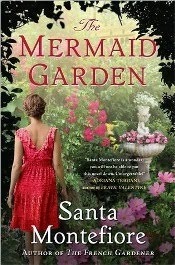 Santa Montefiore's novels combine gorgeously rendered settings, touching romance, and characters facing real world issues such as societal pressures and generational conflicts. Although one of its plotlines is set in the present day (2009) and the other forty years earlier, The Mermaid Garden doesn't have the hallmarks of a historical novel and shouldn't be judged as one. Other than an absence of technology, an emphasis on class differences, and the mention of a Bob Dylan song, there isn't much to indicate a timeframe in the earlier storyline. It's a strong sense of place rather than time that predominates, along with the impressions that the past never really goes away — and that second chances are there for the taking, for those courageous enough to grab them.
Santa Montefiore's novels combine gorgeously rendered settings, touching romance, and characters facing real world issues such as societal pressures and generational conflicts. Although one of its plotlines is set in the present day (2009) and the other forty years earlier, The Mermaid Garden doesn't have the hallmarks of a historical novel and shouldn't be judged as one. Other than an absence of technology, an emphasis on class differences, and the mention of a Bob Dylan song, there isn't much to indicate a timeframe in the earlier storyline. It's a strong sense of place rather than time that predominates, along with the impressions that the past never really goes away — and that second chances are there for the taking, for those courageous enough to grab them.Floriana Farussi is a ten-year-old girl living in poverty in the village of Herba in Tuscany in the summer of 1966. When Dante Bonfanti, the teenage son of a wealthy businessman, catches her spying through the gate of his family's 15th-century palazzo, he brings her through the main entrance and gives her a tour. With an alcoholic father and an absent mother, Floriana fits in well with the stray animals that populate the grounds, and she charms Dante and his family just as easily. The mermaid garden at La Magdalena becomes her sanctuary. Six years later, Floriana grows into a beautiful young woman, and she and Dante fall in love. Optimistic and innocent, Floriana believes their relationship stands a chance.
In the summer of 2009, Marina Turner runs an Italianate-style hotel in Devon, England, with her beloved husband, Grey. She has poured her heart into restoring it and will do anything to keep it afloat despite being in debt up to her ears. In the hopes of attracting new business, she advertises for an artist-in-residence who will teach her mostly elderly clientele how to paint. Argentine painter Rafa Santoro is the perfect choice; not only is he talented, handsome, and clever, but he seems to be exerting a calming influence on Marina's grumpy stepdaughter, Clementine – and maybe more than that, too. Rafa is reticent about his past, though, and there's a hotel burglar on the loose in the area…
Romantic and uplifting without being sappy, the novel lilts smoothly between locales and decades. While the tie between the two plotlines isn't hard to predict, the twist at the end comes as a surprise. Because it's classic summer escapism, it can be described as a beach read, but the characters are more complex than you'd expect from that. There's humor, too, in a subplot involving Clementine's stuffy boss and the risqué hanky-panky he gets into with his mistress. This is a book to bring outside to read in your own exotic garden, but if you don't have one, settle back and let Montefiore's novel conjure up its lush, tranquil atmosphere for you.
The Mermaid Garden was published in June by Touchstone/Simon and Schuster at $24.99 (419pp, hardcover). The British edition, called The House by the Sea, was published by Simon & Schuster UK in July at £12.99.
Published on August 01, 2011 18:30
Winners of Moon in Leo
A quick note to announce the winners of the Moon in Leo ebook - congratulations to Melissa and Sarah, the other librarian!
I'll be in touch via email with download instructions. Hope you enjoy the read, and thanks to everyone who entered.
I'll be in touch via email with download instructions. Hope you enjoy the read, and thanks to everyone who entered.
Published on August 01, 2011 17:54
July 25, 2011
An interview with Stewart Binns, author of Conquest
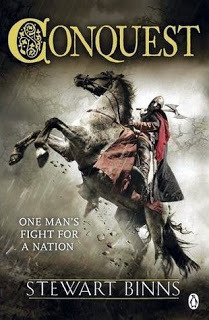 Today Stewart Binns is visiting the blog to respond to some questions about his new novel Conquest, fast-paced adventure fiction about Hereward of Bourne – or Hereward the Wake, as he's better known. A legendary English hero whose existence is historically documented, Hereward led the resistance to the Normans' conquest of England in the landmark year of 1066. The principal story of Conquest, however, begins thirteen years beforehand. A strong and impetuous young man of eighteen, Hereward is a brilliant fighter who still has much to learn about the ways of the world.
Today Stewart Binns is visiting the blog to respond to some questions about his new novel Conquest, fast-paced adventure fiction about Hereward of Bourne – or Hereward the Wake, as he's better known. A legendary English hero whose existence is historically documented, Hereward led the resistance to the Normans' conquest of England in the landmark year of 1066. The principal story of Conquest, however, begins thirteen years beforehand. A strong and impetuous young man of eighteen, Hereward is a brilliant fighter who still has much to learn about the ways of the world.Conquest was the first major novel about Hereward the Wake to appear in quite a while, and there have been several other authors writing about the tumultuous events of 11th-century England just within the last year, too. What attracted you to this time period, and why do you think readers are so interested in it now in particular?
I've always been fascinated by 11th century England and 1066 in particular. I think Senlac Ridge was the critical defining moment in English/British history where the outcome determined the kind of country England became and all that led from it: Britishness, Anglo-American (western) culture etc. It was a great battle in every sense: its consequences, its intensity, its protagonists and the fact that the margin between defeat and victory was so close. Hardrada and Stamford Bridge are part of this as well, and I've always been intrigued by the mix of Celt, Norse, Norman and Anglo-Saxon at the time and how different England and the modern world would have been if either Harald, or Harold had emerged victorious instead of William.
Hereward is an enigmatic figure with wonderful William Wallace-like hero potential, and I thought he was the perfect character to build both an heroic adventure around and to tell the story of those amazing times.
I think there is growing interest in English history at the moment as the English try to define themselves afresh in a newly-devolved Britain. Now that the Scots, Welsh and Irish are off doing their own thing, 'Britain' no longer exists in the way the English defined it, as, effectively, 'Greater England'. The English tended to define 'English' as 'British' and that doesn't work anymore, leaving the English in search of themselves and their past.
The novel is framed around Godwin of Ely's account of his earlier life in England. What made you decide to write the core of the novel in third person rather than first?
I suppose I wanted there to be a circle from The Old Man of the Wildwood and Godwin of Ely and for Hereward to survive into great old age. The Varangian Guard/Byzantium/John the Beautiful were irresistible as well. However, my biggest challenge was how the deal with William would work at the end of the Siege of Ely. Thus, the anonymity clause and the creation of Godwin. There are also factors at play that make book 2 work! (To be published next April).
In working through the material on Hereward's life, how did you decide which elements to take from the myths about him, and which from history?
I only took the bits that seem fairly substantial – the banishment and Ely, the rest is fiction. However, although the book is of course fiction, all the history is spot on in terms of main characters, events and chronology. That is really important to me.
Hereward's wife Torfida (or Torfrida) was a character in Charles Kingsley's 1865 novel about him, but was there any mention of her in other novels, or in history, before he wrote about her? How did you develop her character?
I slightly changed her name (by accident rather than design!) but she is mentioned in the 12th century Gesta. I wanted a strong female character, slightly mysterious and somewhat tragic. It is also mentioned that they had twins.
During his time as a mercenary, Hereward and his company travel throughout many parts of Britain and Europe - Ireland, Scotland, Scandinavia, Sicily, the Alps, France, and elsewhere. Did you get the chance to visit any of these sites yourself?
I have a policy only to write about places I've been to and can visualise. I'm lucky, I've travelled a lot!
The novel's action scenes certainly feel very realistic! What was your most enjoyable battle scene to write?
I'm told I write battles well. Two reasons I think: My day job is as a documentary-maker, so I suppose I think in pictures. Also, as an ex-soldier, I know how they think.
Most enjoyable battle scene to write - Senlac Ridge of course – one of the most important battles in world history. I really enjoyed trying to explain how it might have happened, especially the astonishing bravery on both sides. I'm also quite fond of Ely. There is no known detail of what happened there, so an author's paradise!
What do you hope readers get out of reading Hereward's story?
Superficially, a good action/adventure romp through a great period of history and beneath that some thoughts about good and evil, right and wrong, truth and myth; some questions about courage and sacrifice and beneath those a little thesis about the making of England.
Conquest was published in February by Penguin UK at £6.99 (pb, 497pp).
Published on July 25, 2011 22:00
July 22, 2011
Book review: A Lesson in Secrets, by Jacqueline Winspear
 Jacqueline Winspear's eighth Maisie Dobbs mystery demonstrates the truth spoken by one of her characters: "One always has riches when one has a book to read." This is my first outing with Maisie, who by 1932 is a successful private detective in London. Feeling that I ought to get up to speed with this award-winning series, I requested a copy of A Lesson in Secrets to review. Reading novels out of order doesn't bother me; if an author does her job well, the order shouldn't matter, plus starting with a later volume gets me interested in reading about the characters' past histories, too.
Jacqueline Winspear's eighth Maisie Dobbs mystery demonstrates the truth spoken by one of her characters: "One always has riches when one has a book to read." This is my first outing with Maisie, who by 1932 is a successful private detective in London. Feeling that I ought to get up to speed with this award-winning series, I requested a copy of A Lesson in Secrets to review. Reading novels out of order doesn't bother me; if an author does her job well, the order shouldn't matter, plus starting with a later volume gets me interested in reading about the characters' past histories, too.Maisie's outward sophistication belies her humble origins as a domestic servant to the aristocratic Comptons – a family whose son James is now Maisie's beau. In the years following World War I, the social fabric of Britain has unraveled and re-formed. The political climate is likewise shifting, not necessarily for the better. At the request of the British Secret Service and Scotland Yard, Maisie takes a post as a junior lecturer in philosophy at a small Cambridge college that has been enrolling an unusual number of students from abroad. Her task is to keep her ear to the ground for any activities "not in the interests of the Crown."
Greville Liddicote, the founder of St. Francis, has pacifist leanings, and his institution's curriculum is grounded in his principles. A controversial children's book he wrote during World War I turned many would-be soldiers into "Conchies" – conscientious objectors – and reportedly caused a mutiny on the front lines. (If this event ever occurred, that is. The British government has kept the truth under wraps.) When Liddicote is found murdered in his office, Maisie is asked to stick to her own investigation and let Special Branch do its job, but everything is closely entangled, of course. The more Maisie learns about her fellow instructors and their connections, the closer she comes to unveiling a murderer.
The plot of A Lesson in Secrets is not so much suspenseful as intellectually provocative. Although she is new on the faculty, Maisie's natural ease with her peers and students gets them talking, and her inquiry is neatly worked into the history of the period. The Nazi party on the rise in Germany is attracting followers throughout Britain and Europe. Few besides Maisie are attuned to the threat it may pose.
For a newcomer to the series like me, Maisie seems a little too perfect at first: she can quickly discern a cause of death, conduct a well-received philosophy lecture with little preparation, and is remarkably aware of her surroundings. For her, success lies not just in what you know, but in who you know. Over time, she has accumulated enough contacts who provide her with the information she seeks – even if it sometimes leads her up the wrong path.
Maisie is too wary of "happily ever after" endings for her romance with James to be smooth sailing, however, and episodes in her personal life still manage to surprise her. The mix makes her an intriguing character, and I'm now curious about her transformation from servant to wartime nurse to PI. Her back story is well developed here, and the secondary characters are equally well crafted. Even her late mentor Maurice Blanche, who had left her enough funds in his will to make her financially independent, lives on the page as a close memory. I look forward to meeting him in person in Winspear's earlier books.
A Lesson in Secrets was published in April by Harper ($25.99, 323pp, hardcover).
Published on July 22, 2011 12:24
July 16, 2011
A look at Kathleen Herbert's Moon in Leo, plus a giveaway
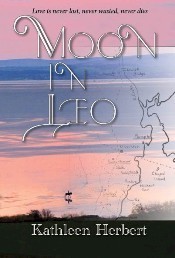 First, a disclosure: a quote of mine, based on my reading of Kathleen Herbert's Dark Ages trilogy from the mid-'80s, is printed on the back cover and first page of Moon in Leo. Not surprisingly, the words I'd written earlier proved to be true about this book as well:
First, a disclosure: a quote of mine, based on my reading of Kathleen Herbert's Dark Ages trilogy from the mid-'80s, is printed on the back cover and first page of Moon in Leo. Not surprisingly, the words I'd written earlier proved to be true about this book as well:"I've always loved Kathleen Herbert's work. Written with sensitivity, passion, and an extraordinarily vivid sense of place, her novels reflect the realities of life in a bygone age while still evoking all of its magic."
Moon in Leo takes place on the Furness peninsula in south Cumbria, England, a remote land of sparkling estuaries, rocky woodlands, and wide skies that glow pink and lavender in the setting sun. (See the cover at left.) The novel is saturated with atmosphere to the extent that the setting becomes almost a character in itself. In this beautiful yet perilous place, wayfarers who manage to pull themselves free of Morecambe Bay's treacherous sands can find sanctuary on Chapel Island – the spot where Moon in Leo begins and ends.
Rosamund Halistan comes from a family of alchemists who have always kept to themselves, which means that she has been more sheltered from the world than other young women of her age. In 1678, her twin brother Stephen returns home from a long stay abroad. Although Rosamund had hoped to become his lifelong partner in the mystical arts, Stephen's interests no longer lie in that direction; he had fallen in love with the exuberant Italian culture and, more dangerously, the religion of its people. Rosamund finds evidence that someone's out to kill him, and she's right.
Even eighteen years after Charles II's restoration, memories of the Civil War remain at the forefront of everyone's minds. To help keep the peace in a company of mixed faiths and political allegiances, Rosamund and Stephen agree to attend a house party organized by Sir John Westby, a former Royalist, and his wife, Prudence, a former Parliamentarian. Dark undercurrents of schemes and deception flow through the conversations, and though Rosamund doesn't catch all of the nuances, she finds herself caught in the thick of the action. When tragedy forces her to confront the layers of corruption in the highest circles of the realm, she determines to preserve what means most to her: her family.
Two suitors vie for her hand, one a fellow seeker of alchemical truths, the other a gentleman of the royal bedchamber. As an heiress, she's a hot commodity, and whether they have their eye on her person or her fortune (or both) is unclear. Rosamund is a true ingénue trapped in a world swirling with intrigue, and while she struggles to find a foothold, her naïveté means that the reader doesn't know whom to trust either. Reality versus illusion is one of the novel's most prominent themes, and over its course, the multifaceted characters are seen from numerous angles.
This lengthy book is set against the backdrop of the Popish Plot, a fictional conspiracy drummed up by Titus Oates in an effort to incite violence against England's Catholics and prevent them from holding power. The historical background is solid, and the storyline feels intensely romantic, at least until one looks beneath the surface. While declarations of affection abound, amid pet names of "dear" and "darling" and "oh my love," women in this sparsely populated countryside must rely on male protectors, and few women in this book choose wisely – if they're permitted to choose at all. Herbert's lush style can make it feel as if one was reading a classic written many years ago rather than a modern work. As a result, the many songs and bawdy rhymes inserted into the text feel even more authentic to the storyline she creates.
Ghostly visitations, sigils charged with magic, and hermetic spells play such a strong role that I sometimes felt as if I'd stepped into a Dion Fortune novel. Although most of the characters don't believe in such things, these occult happenings definitely feel real to Rosamund, influencing her actions beyond what feels natural. The multiplicity of religious beliefs in this deep, involving read make her world feel genuine, as do the well-crafted depictions of ordinary people – nobles, scholars, courtiers, and gypsies – caught in the tide of history.
Moon in Leo was published by Trifolium Books earlier this year (£11.99, trade pb, 401pp).
Contest info: I'm holding a giveaway for two electronic copies of Moon in Leo; the winners will be given directions by which they can download a copy at no charge from Smashwords. To enter, please leave a comment on this post. Deadline July 29th.
Published on July 16, 2011 08:00
July 14, 2011
A spotlight on Jude Morgan's next novel
Longtime blog readers may remember my high praise for Jude Morgan's The Taste of Sorrow, a masterful work about the Brontës. One of the things I enjoy most about his biographical novels is how carefully he matches his approach and his subjects; his books are all excellent, yet each is stylistically different from the others. He writes about artistic types, musicians and writers and such, and his books show deep insight into the creative process.
While glancing at my recent purchase of his subsequent novel, A Little Folly - he's been alternating biographical treatments with more lighthearted Regency fare - it occurred to me that it would be time for something new from him very soon.
So I checked Amazon UK, et voilà. The Secret Life of William Shakespeare will be out from Headline Review on March 1st next year, and here's the plot description, from the publisher:
The title is gimmicky, but it's what's inside that matters. Did I preorder it? You bet.
While glancing at my recent purchase of his subsequent novel, A Little Folly - he's been alternating biographical treatments with more lighthearted Regency fare - it occurred to me that it would be time for something new from him very soon.
So I checked Amazon UK, et voilà. The Secret Life of William Shakespeare will be out from Headline Review on March 1st next year, and here's the plot description, from the publisher:
The greatest writer of them all, brought to glorious life.
How well do you know the man you love? How much do you think you know about Shakespeare? What if they were one and the same? He is an ordinary man: unwilling craftsman, ambitious actor, resentful son, almost good-enough husband. And he is also a genius. The story of how a glove-maker from Warwickshire became the greatest writer of them all is vaguely known to most of us, but it would take an exceptional modern novelist to bring him to life. And now at last Jude Morgan, acclaimed author of Passion and The Taste of Sorrow, has taken Shakespeare's life, and created a masterpiece.
The title is gimmicky, but it's what's inside that matters. Did I preorder it? You bet.
Published on July 14, 2011 16:40



